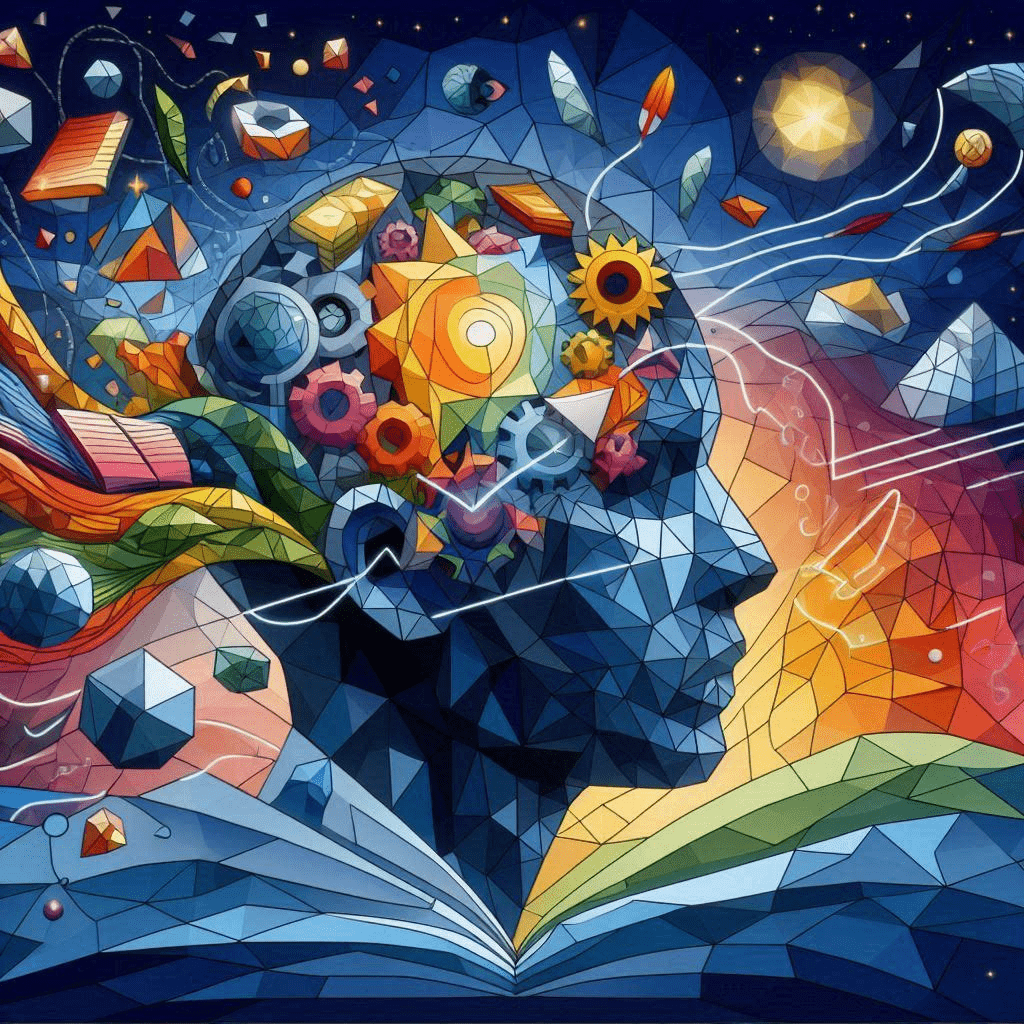How Our Thoughts and Words Paint the Reality Around Us
In a world where our thoughts race and words flow endlessly, there’s a profound concept that’s been whispered through the ages – one that ties the mystic threads of ancient wisdom to the bright collage of modern understanding. This concept suggests that everything we imagine, think, or speak is manifested in a realm of existence, unseen yet immensely powerful. It’s a notion that bridges the gap between the tangible and the intangible, the seen and the unseen, the material and the spiritual.
The ancient sages and philosophers hinted at this truth in their teachings. Fast forward to today, and you’ll find echoes of this wisdom in various aspects of life – from self-help books to motivational speeches, from the silent chambers of meditation halls to the bustling streets where everyday conversations take place. But how does this concept translate into our daily lives? How do the silent whispers of our thoughts and the words we speak create ripples in the fabric of reality?
Imagine this: a young person, sitting by a window, gazing at the stars, dreaming of becoming an astronaut. That dream, invisible and intangible, is a seed planted in the fertile ground of the universe. Each thought nurtures this seed, each word waters it, until one day, it might just blossom into reality. This is not just a poetic metaphor; it’s a reflection of a deeper truth that surrounds us – a truth that we are about to explore in the journey of this blog.
Join us as we delve into the realms of ancient wisdom, scientific understanding, and practical knowledge to unravel the mystery of how our thoughts and words shape the world we live in. Let’s embark on this journey together, unraveling the secrets of the universe, one thought, one word at a time.
The Concept of Manifestation
In the fabric of our lives, each thought and word is like a thread weaving its unique pattern. This idea isn’t new; it’s been a cornerstone in various philosophies and spiritual teachings for millennia. At its core, the concept of manifestation asserts that our internal dialogue and spoken words have the power to shape our reality. It’s an intriguing thought: what if the invisible realms of our thoughts and words are indeed crafting the visible world around us?
The Power of Thoughts
Thoughts are more than mere electrical impulses in the brain; they are the architects of our destiny. This might sound like an overstatement, but consider how every great invention, every work of art, every human achievement began as a mere thought. Ancient Greek philosopher Plato spoke of the world of ideas or forms, a realm where every concept exists in its perfect state. In our context, each thought is a reflection of those forms, shaping our reality in its image.
The Strength of Words
Words carry immense power. They can uplift or destroy, create or annihilate. In many ancient traditions, the world itself was spoken into existence. For instance, in the Biblical creation story, God says, “Let there be light,” and light appears. Similarly, in Hinduism, the sacred sound ‘Om’ is believed to be the vibration from which the entire universe emanated. Our words, though seemingly small and insignificant, ripple through the cosmos, manifesting in ways we might not immediately perceive.
Interconnection with the Universe
This concept takes a holistic view of existence. We’re not isolated beings; rather, we’re intricately connected to the universe. Every thought and word is like a signal sent out into the cosmos, interacting with the energies around us. The ancient Chinese philosophy of Taoism emphasizes this interconnectedness. In Taoism, the harmony between humans and the natural world is paramount. Our thoughts and words are part of this harmonious exchange, influencing and being influenced by the universe.
Manifestation in Daily Life
How does this translate to our everyday experience? Consider the impact of constantly thinking you’re incapable of achieving something. These thoughts build an invisible barrier, a self-fulfilling prophecy. On the flip side, positive thinking opens doors, creates opportunities, and attracts success. It’s not magic; it’s a combination of mindset, perception, and action – all initiated by our thoughts and words.
Historical Perspectives
Throughout history, the idea that our thoughts and words have the power to shape our reality has surfaced in various cultures and philosophies. This universality suggests a deep-seated truth, recognized by humanity across time and space. Let’s explore how different civilizations and thinkers have echoed this concept.
Ancient Greek Philosophy
The ancient Greeks, renowned for their philosophical inquiries, touched upon this idea. Plato, for instance, spoke of the world of forms – a realm of perfect ideals from which our reality is but a shadow. Aristotle, too, emphasized the power of the mind in shaping our experiences. These philosophies hint at an underlying principle: our reality is a reflection of deeper, unseen forces, shaped in part by our own perceptions and declarations.
Eastern Wisdom
In Eastern philosophies, particularly in Hinduism and Buddhism, the concept of manifestation is deeply ingrained. The Hindu scriptures, like the Bhagavad Gita, teach that our thoughts and words are not merely personal expressions but vibrations that affect the cosmos. Buddhism, with its emphasis on intention and mindfulness, also supports the idea that our inner dialogues have profound external consequences.
Mystical Traditions
Mysticism across various traditions often speaks of the creative power of the word. The Jewish mystical tradition of Kabbalah, for instance, sees the Hebrew alphabet as the building blocks of creation. In Sufism, the mystical branch of Islam, poets like Rumi spoke of the universe responding to our deepest desires and thoughts, echoing the belief that our internal state shapes our external reality.
Indigenous Wisdom
Indigenous cultures around the world have long held the belief in the power of words and thoughts. Many Native American tribes, for example, practice spoken word rituals, understanding that words are not merely sounds but carriers of energy with the power to impact the world.
The Renaissance and Beyond
Even during the Renaissance, a period marked by a renewed interest in classical philosophy and the rise of humanism, this concept found its way into literature and art. Shakespeare, in his plays, often alluded to the idea that our perceptions shape our reality. In more modern times, thinkers like Ralph Waldo Emerson and William James have echoed similar sentiments.
Scientific Angle
Moving from ancient wisdom and historical perspectives, let’s explore how modern science – particularly psychology, neuroscience, and quantum physics – aligns with the concept that our thoughts and words can shape our reality.
Psychology and the Power of Mindset
In psychology, the impact of mindset on our behavior and life outcomes has been extensively studied. Dr. Carol Dweck’s research on ‘fixed’ vs. ‘growth’ mindsets illustrates this. A fixed mindset confines individuals to their perceived limitations, while a growth mindset opens up possibilities for learning and growth. This aligns with the ancient concept of manifestation, suggesting that our beliefs and internal dialogues can significantly shape our life paths.
Neuroscience: Thoughts and Brain Plasticity
Neuroscience has shown that our thoughts can physically alter our brains – a phenomenon known as neuroplasticity. Regular patterns of thought and speech can strengthen certain neural pathways while weakening others, effectively reshaping our brain structure over time. This biological change underpins the idea that habitual thoughts and words can manifest changes in our lives, not just metaphorically, but also physically.
The Placebo Effect: Belief and Healing
The placebo effect is a powerful testament to the mind’s ability to affect the body. Patients given a placebo, often a sugar pill, can experience real improvements in health conditions, purely because they believe they are receiving treatment. This phenomenon demonstrates how belief (a form of thought) can manifest physical changes, providing scientific backing to the ancient concept of thoughts shaping reality.
Quantum Physics: Observer Effect
Quantum physics offers perhaps the most direct parallel to the ancient concept of manifestation. The observer effect in quantum mechanics suggests that the act of observation can alter the state of a particle. This has led some scientists and philosophers to theorize that consciousness (which begins with thought) may play a fundamental role in shaping reality. While this remains a hotly debated topic, it does provide a scientific framework that echoes the ancient beliefs about the power of thought and word.
Practical Implications
Understanding the concept of manifestation is one thing, but applying it in our daily lives is where its true power lies. This section delves into practical ways to harness the power of thoughts and words, turning theory into tangible results.
Mindfulness and Awareness
The first step in harnessing this power is mindfulness – being aware of our thoughts and words. This awareness allows us to identify negative patterns and replace them with positive affirmations. Mindfulness practices, such as meditation, help in cultivating an environment where positive thoughts can flourish. Just as a gardener tends to their garden, we must tend to our mental landscape, weeding out harmful thoughts and nurturing positive ones.
Affirmations and Positive Speech
Affirmations are positive statements that, when repeated often, can help to reshape our thinking and speaking patterns. For example, instead of saying, “I can’t do this,” one could affirm, “I am capable and strong.” Over time, these affirmations can rewire our brain, as suggested by the concept of neuroplasticity, leading to more positive actions and outcomes.
Visualization Techniques
Visualization is another powerful tool. It involves vividly imagining achieving a goal or embodying a desired state. Athletes often use this technique to improve performance, picturing themselves winning a race or scoring a goal. This practice aligns with the concept of manifestation, as it roots the idea of success in the mind, which then strives to translate it into reality.
Gratitude Practices
Gratitude is a transformative practice. By focusing on and expressing gratitude for what we have, we shift our attention from lack to abundance, fostering a mindset that is conducive to positive manifestation. Keeping a gratitude journal or regularly expressing gratitude can have profound effects on one’s mental and emotional well-being.
Real-Life Success Stories
Countless success stories attest to the power of positive thinking and speaking. For instance, Jim Carrey famously wrote himself a check for $10 million for “acting services rendered,” dating it five years into the future. He carried it in his wallet, and within those five years, he achieved his acting breakthrough and earned a paycheck matching that amount. This story illustrates how a clear vision, backed by belief and effort, can manifest into reality.
Challenges and Misconceptions
While the concept of manifestation is powerful, it’s essential to approach it with a balanced perspective. This section addresses common challenges and misconceptions to help readers maintain a realistic and healthy approach to the idea of thoughts and words shaping reality.
Misconception 1: Instant Results
One of the biggest misconceptions about manifestation is the expectation of instant results. Reality, however, doesn’t always align with our timelines. Manifestation is often a gradual process that involves consistent effort, patience, and belief. It’s important to understand that while our thoughts and words are powerful, they are part of a larger tapestry of actions, circumstances, and timing.
Misconception 2: Positive Thinking Alone Is Enough
Another common misunderstanding is the belief that positive thinking alone can manifest desired outcomes. While positive thoughts and words are crucial, they must be accompanied by action. For instance, dreaming about a successful career is a start, but taking concrete steps towards that goal is essential. This aligns with the ancient teachings, which often emphasize the balance between thought, word, and deed.
Challenge: Overcoming Negative Thought Patterns
A significant challenge in practicing manifestation is overcoming deeply ingrained negative thought patterns. This can be particularly difficult in the face of setbacks or ingrained beliefs. Mindfulness and cognitive behavioral techniques can be useful in identifying and transforming these patterns. It’s a journey of self-discovery and growth, requiring commitment and resilience.
Misconception 3: Manifestation Leads to Material Success Only
Some people mistakenly equate manifestation with material success. However, the concept is more about aligning with one’s true purpose and finding fulfillment, which may not always mean material wealth. It’s about creating a life that resonates with one’s values and brings inner peace and happiness.
Challenge: Misinterpretation of Signs and Outcomes
Interpreting every event as a sign or direct result of one’s thoughts can lead to misconceptions. Not every setback is a manifestation of negative thinking, just as not every success is solely the result of positive thought. Life is complex, and many factors contribute to outcomes. It’s important to maintain a grounded and realistic perspective.
Aligning Thoughts and Emotions – The Symphony of Vibrations and Frequencies
In the realm of manifestation, thoughts and emotions play pivotal roles, each contributing uniquely to the process of bringing desires into reality. This section delves into the fascinating interplay between thoughts (as vibrations) and emotions (as frequencies), exploring how their alignment can lead to profound changes in our lives. We will draw upon ancient wisdom, including Hermetic principles and teachings from the Kybalion, to deepen our understanding of this concept.
The Nature of Thoughts and Emotions
Thoughts, according to various spiritual and philosophical teachings, are considered vibrations. They are energetic waves emanating from our conscious mind, interacting with the universe. Emotions, on the other hand, are often described as frequencies – the resonant patterns these vibrations create within our deeper, subconscious selves. While thoughts are the seeds of intention, emotions water these seeds, giving them the energy to grow.
Hermetic Principles and the Kybalion
The ancient Hermetic teachings, encapsulated in texts like the Kybalion, provide profound insight into the nature of the universe and our place within it. One of the key principles, “As Above, So Below; As Within, So Without,” suggests a mirroring between the macrocosm (the universe) and the microcosm (the individual). This principle can be applied to our thoughts and emotions: the harmony (or disharmony) within ourselves is reflected in the reality we experience.
The Power of Alignment
When thoughts and emotions are aligned, they create a powerful synergy. Think of it like an orchestra: when all instruments are in tune and playing in harmony, the music produced is beautiful and impactful. Similarly, when our thoughts (intentions) are in harmony with our emotions (feelings), we create a resonance that can effectively manifest our desires.
Emotions as the Catalyst
Emotions can be seen as the catalyst in the manifestation process. While a thought decides the direction, emotion provides the momentum. High-frequency emotions like love, joy, and gratitude can elevate our vibrational state, making it more conducive to manifesting positive outcomes. Conversely, low-frequency emotions like fear, anger, and sadness can hinder this process.
Practical Applications
In practical terms, aligning thoughts and emotions involves becoming consciously aware of our feelings and deliberately choosing thoughts that resonate with positive emotional states. Techniques such as emotional freedom techniques (EFT), meditation, and journaling can help in achieving this alignment.
Case Studies and Examples
Historical and contemporary examples abound where individuals have harnessed this alignment for remarkable achievements. Artists, scientists, and leaders have often spoken of moments where a powerful emotion, aligned with a clear thought or vision, led to breakthroughs and innovations.
The Role of Visualization and Affirmation
Visualization and affirmation practices can be powerful tools in aligning thoughts and emotions. By visualizing a desired outcome and affirming it with emotion-filled words, we can start to bring our thoughts and emotions into alignment, creating a vibrational match for our desires.
Overcoming Challenges in Alignment
Aligning thoughts and emotions is not always straightforward. Emotional blockages and negative thought patterns can disrupt this alignment. Addressing these challenges often requires introspection, healing, and sometimes professional guidance.
Insights from Thoth and Ancient Wisdom
Thoth, the ancient Egyptian deity of wisdom, often associated with Hermeticism, emphasized the importance of knowledge and understanding in achieving balance and harmony. Drawing from this wisdom, we see that knowledge of our own thought and emotional patterns is crucial in mastering the art of manifestation.
A Harmonious Dance
The alignment of thoughts and emotions is like a harmonious dance that shapes the fabric of our reality. By understanding and applying this concept, we can learn to consciously create a life that resonates with our deepest desires and aspirations. This journey is not just about achieving specific goals but about finding harmony within ourselves and, consequently, in the world around us.
Conclusion
As we draw this exploration to a close, let’s reflect on the journey we’ve taken. From the ancient wisdom of philosophers and mystics to the modern insights of psychology and neuroscience, we’ve seen how the concept that our thoughts and words can manifest realities has resonated through time and across cultures. It’s a powerful reminder of our interconnectedness with the universe and the potential that lies within our minds and hearts.
We’ve learned that manifestation is not about instant gratification or material gains alone, but a profound alignment with our deepest intentions and desires. It’s a process that requires mindfulness, patience, and action. By nurturing positive thoughts, engaging in affirmations, practicing visualization, and expressing gratitude, we can start to reshape our world from the inside out.
However, it’s crucial to approach this concept with balance and realism. Overcoming negative thought patterns and understanding the role of effort and timing are key to effectively manifesting our aspirations. Manifestation is not a magic wand but a tool for personal and spiritual growth, helping us to align with our true purpose and potential.
As we move forward, let’s remember the words of the ancient philosopher Lao Tzu, who said, “Watch your thoughts, they become your words; watch your words, they become your actions; watch your actions, they become your habits; watch your habits, they become your character; watch your character, it becomes your destiny.” This profound statement encapsulates the essence of manifestation – our thoughts and words are not just fleeting echoes in the void but powerful forces that shape our destiny.
May this understanding inspire you to be mindful of your inner dialogue and the words you speak, knowing that in every moment, you hold the power to weave the tapestry of your life. Embrace this journey with an open heart and mind, and watch as the world unfolds in response to the song of your soul.








